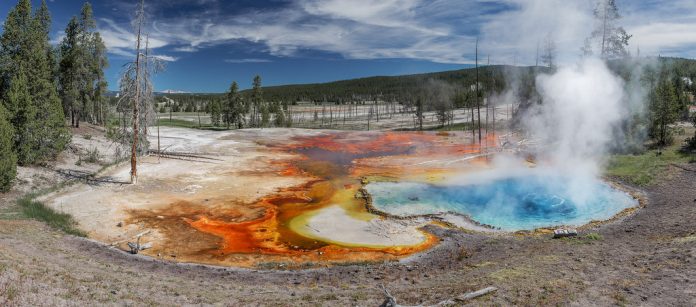
Researchers from Arizona State University recently presented their findings at IAVCEI’s 2017 Scientific Assembly, after spending weeks studying Yellowstone’s Lava Creek Tuff. Minerals extracted from the site suggest an eruption from this supervolcano might take decades instead of centuries as previously thought.
This has led numerous outlets to say that Yellowstone will erupt tomorrow and that the aftermath of the disaster will result in a global extinction. This is simply not true, although the consequences of such an event would definitely have a large-scale impact whenever it happens.
There is still much to be learned from volcanoes, and particularly from supervolcanoes like the one beneath the Yellowstone National Park. In the United States alone there are two of these formations, the other one being located underneath California’s Long Valley caldera.
Scientists made a surprising discovery about a supervolcano from the remains of Yellowstone’s last supereruption https://t.co/F6X3s4xBKF
— The New York Times (@nytimes) October 11, 2017
A supereruption could happen in the span of a human lifetime
Hannah Shamloo and Christy Till of Arizona State University set camp on the Lava Creek Tuff in Yellowstone over the course of several weeks to collect samples of volcanic ash settlements near the tuff. Save for the occasional bear, research was extensive and their findings surprising.
The scientists were looking for traces of phenocrysts, which are special crystals that form as new magma cools down in the innards of volcanoes. As they examined each layer of crystals from volcanic ash samples, they realized that the formations showed evidence of rapid change in temperature and other elements.
Different levels of pressure and water content along with temperature changes, at which the crystals formed, indicate that layers upon layers took mere decades to pile on top of one another. This, in turn, led scientists to conclude that the lapse between buildup and supereruption actually takes just a few decades.
If the Yellowstone supervolcano erupts, we're in big trouble. What could we do to stop it? pic.twitter.com/jyo2bRgxDV
— Discover Magazine (@DiscoverMag) October 11, 2017
Could Yellowstone’s eruption lead the world to mass extinction?
No. The supervolcano resting dormant under Yellowstone has the potential to spit out 1,000 cubic kilometers of volcanic ash and rocks, and the resulting ash cloud could cover an area roughly the size of the western half of the United States.
The gases expelled from the depths of the Earth will probably affect the entire planet, though, as they disperse carried by wind currents and shield us from some of the sun’s rays. This phenomenon will likely result in a global cooldown that will last for some time, but nothing near another ice age or some mass extinction.
American soil will probably gather as much as 4 inches of ash in the areas nearest to the supereruption, and the effects of harmful gasses, acid rain, and ash clouds will probably be felt the most in the Midwest, where crops and livestock will see themselves severely affected.
Some news outlets point out that the last two eruptions in Yellowstone occurred 1.3 million years and 640,000 years ago, locating us living on Earth today in the timeframe for the next potential catastrophic event. Rest assured, though, that scientists believe we are still a couple thousand years away from it happening.
Source: The New York Times











